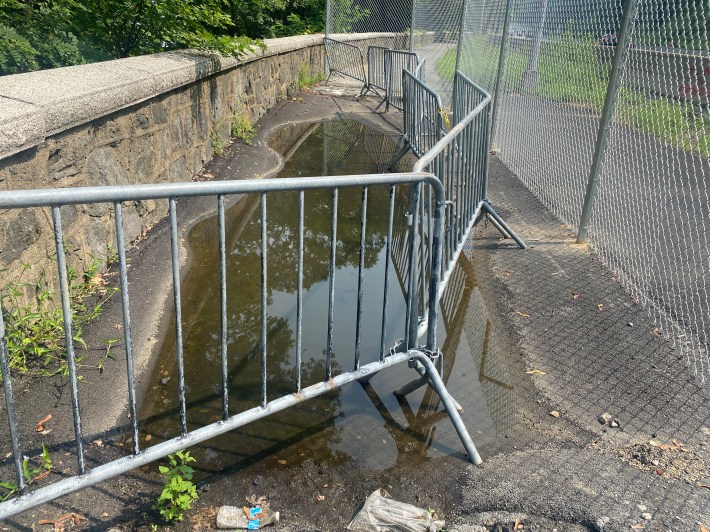A beleaguered section of the Hudson River Greenway uptown continues to collapse and the city in recent weeks built a fence around the massive pothole — less than a year after a million-dollar maintenance project attempted to fix the problem.
The Parks Department patched up the troubled section just north of the greenway's West 181st Street entrance in Washington Heights late last year, as part of a $1.2 million, two-month project to shore up the wall holding up the pedestrian and bike greenway and the adjacent Henry Hudson Parkway — but the fresh pavement sagged within months.
A contractor cordoned off the sinkhole in late May, and paved asphalt on the dirt path next to it as a detour. Parks officials at the time said they would investigate the underlying cause of the collapse.
In the weeks since, the city installed a metal fence with poles set deep into the pavement at the troubled spot.
The $1.2 million repair project required the closure of a 1.4-mile section of the popular greenway between West 181st Street and Dyckman Street — a vital north-south link for the many cyclists in Manhattan and the Northwest Bronx — detouring cyclists onto dangerous neighborhood streets. Officials reopened the path in January.
The pothole and accompanying puddles, which uptown residents feared would get worse due to erosion during summer storms, had become a pond on Monday after a washout weekend.

Locals were not impressed by the current state of the path.
"That’s not right," said Harlemite Rene Bernard as she walked the greenway. "If they got it right the first time this wouldn’t have happened again."
The fence obscures views of oncoming foot and bike traffic. One jogger said the barricades create a dangerous bottleneck, especially on busy weekend days.
"It is even a safety factor," said Inwood resident Charlie, who declined to give his last name.
"You have to automatically yield totally to the right and make sure that guys like this don’t run us over," he said as a man on an e-bike rode past, adding, "It gets hectic, yeah no doubt about it."
Car drivers get three lanes on the underused highway adjacent to the greenway, but Parks officials have shot down proposals by a traffic expert and the local community board to take a lane from auto traffic and turn it into a protected bike path.
Another solution could be waterfront path next to the Amtrak tracks below, according to one uptown bike activist. The path would link up to an existing mile of a "path to nowhere" that extends south from Dyckman Street but dead-ends in the woods just north of the George Washington Bridge.
The city should work with Amtrak to extend that path less than half a mile further to connect with the greenway at the Little Red Lighthouse beneath the bridge, rather than trying to fix the crumbling path on the edge of the cliffs above, said the advocate, Stanley O'Connor.
"They shut it down for two months, they spent millions of dollars, and they’re going to have to do it all over again," he said.
A new lower-level connector would also get rid of the need for greenway users to climb the steep path up from the lighthouse to continue north, a route dubbed "Suicide Hill" by locals like O'Connor.
"Unless I ride my own e-bike, I can’t go up there on a Citi Bike e-bike," the 68-year-old said. "I’m old, it’s tough."
The area could do with some new bike infrastructure, which is consistently in worse shape than sections of the greenway in wealthier neighborhoods downtown, noted one bike commuter who has ridden the riverside route for close to a decade.
"They invest in everything else, but once you get above the George Washington Bridge they don’t invest in bike infrastructure," said the cyclist, Ted Kelemen. "This has been collapsing for years, they need to find a permanent fix. They just keep patching and patching and patching."
The Parks Department has a poor record of maintaining its bike facilities — often the only safe routes through parts of the city lacking protected routes, such as the busted Ocean Parkway malls in southern Brooklyn.
The agency's bad rap of slow capital projects led the City Council to pass a law earlier this year requiring the green space gurus to come up with a plan by December to reduce their timelines by a quarter.
A Parks spokesperson said officials are still investigating the cause of the sinkhole.
"We’re pursing another round of testing which is why the fence remains up," said Izzy Verdery. "The temporary paving was done to ensure safety of park users while we work towards a long-term solution."






